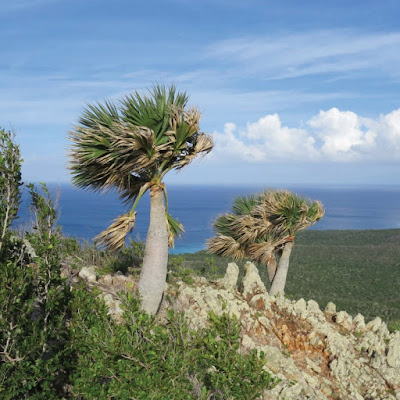 |
| Sabal antillensis M.P.Griff. |
Abstract
A new species of palmetto, Sabal antillensis, native to Curaçao and Bonaire, is described and illustrated. The new species is characterized by a pachycaulous habit, a compact crown of leaves, large seeds, and frequent fiber bundles in leaflet transection. Details on history, morphology, distribution, habitat, and conservation status are provided.
Keywords: anatomy, Coryphoideae, Christoffelpark, Palmae, palms, Southern Caribbean, Monocots
 |
| FIGURE 2. Sabal antillensis, Christoffelpark, Curaçao, showing pachycaul trunk habit, and most leaves held at an angle ascending from the trunk axis (photograph: Griffith). |
Sabal antillensis M.P.Griff., sp. nov.
Diagnosis:— This new species is most similar to Sabal causiarum in leaf morphology and inflorescence structure, but differs in the pachycaul habit, the petioles less than half the total leaf length giving a distinctive densely foliated crown, the smaller and less persistent ligules, the more divided leaf segments and leaf segment apices, the frequent adaxial fiber bundles between most secondary minor leaf segment veins, the inflorescences not pendant below the leaves, the abaxially lepidote sheathing inflorescence bracts, the lower density of flowers on the rachilla, the tubular to cupulate calyx, the larger fruits and the larger seeds.
Distribution:— This species occurs on the islands of Bonaire and Curaçao. On Bonaire, the plants are found in the southern part of the island, west of Lac Bay and north of the solar salt factory. On Curaçao, the plants are within and to the west of Christoffelpark, on the western side of Christoffelberg.
Habitat:— On Bonaire, the plants are found in the Coccoloba–Melocactus Middle Terrace landscape type (de Freitas et al. 2005), on limestone pavements, at elevations near 5 m. On Curaçao, the plants are found in the Bromelia– Schomburgkia Hills landscape type (Beers et al. 1997), on cherty mudstones, at elevations between 140–260 m.
Local Names:— The plant is called Cabana or Sabalpalm in the Dutch Caribbean.
Etymology:— The name honors the Dutch Antilles, where the species is endemic.
M. Patrick Griffith , John De Freitas , Michelle Barros and Larry R. Niblick. 2017. Sabal antillensis (Arecaceae): A New Palmetto Species from the Leeward Antilles.
Phytotaxa. 303(1); 56–64. DOI: 10.11646/phytotaxa.303.1.4
Phytotaxa. 303(1); 56–64. DOI: 10.11646/phytotaxa.303.1.4